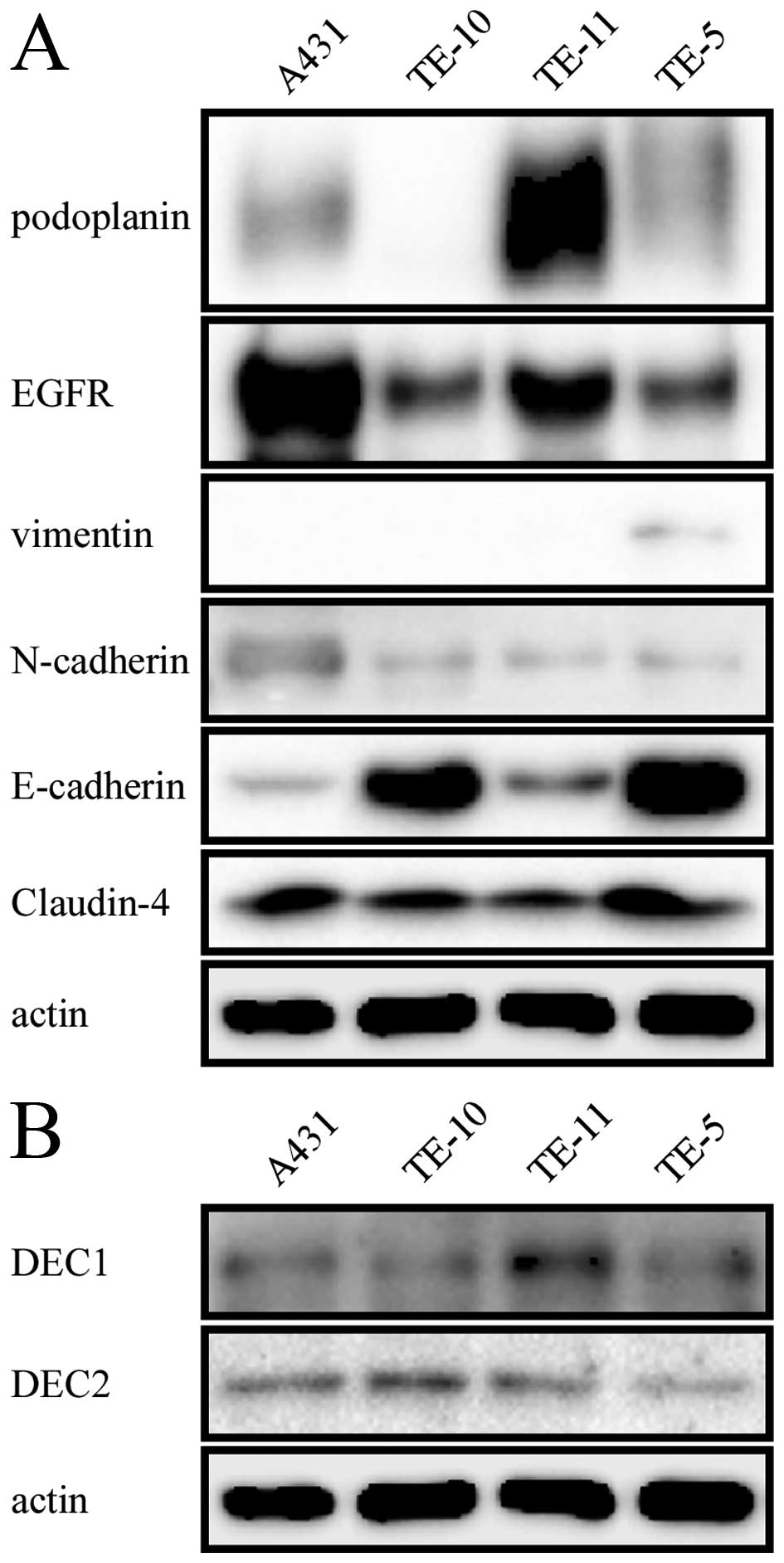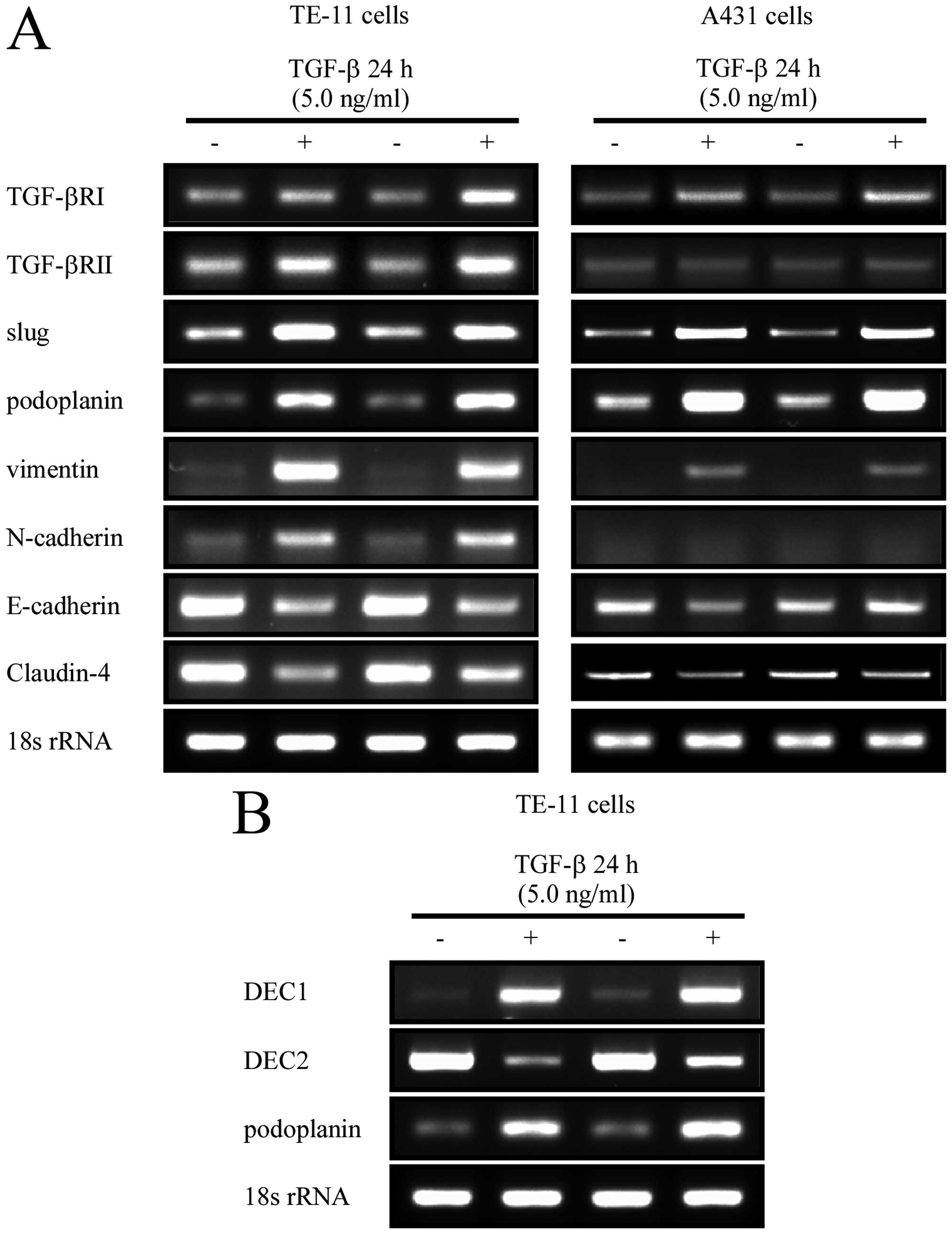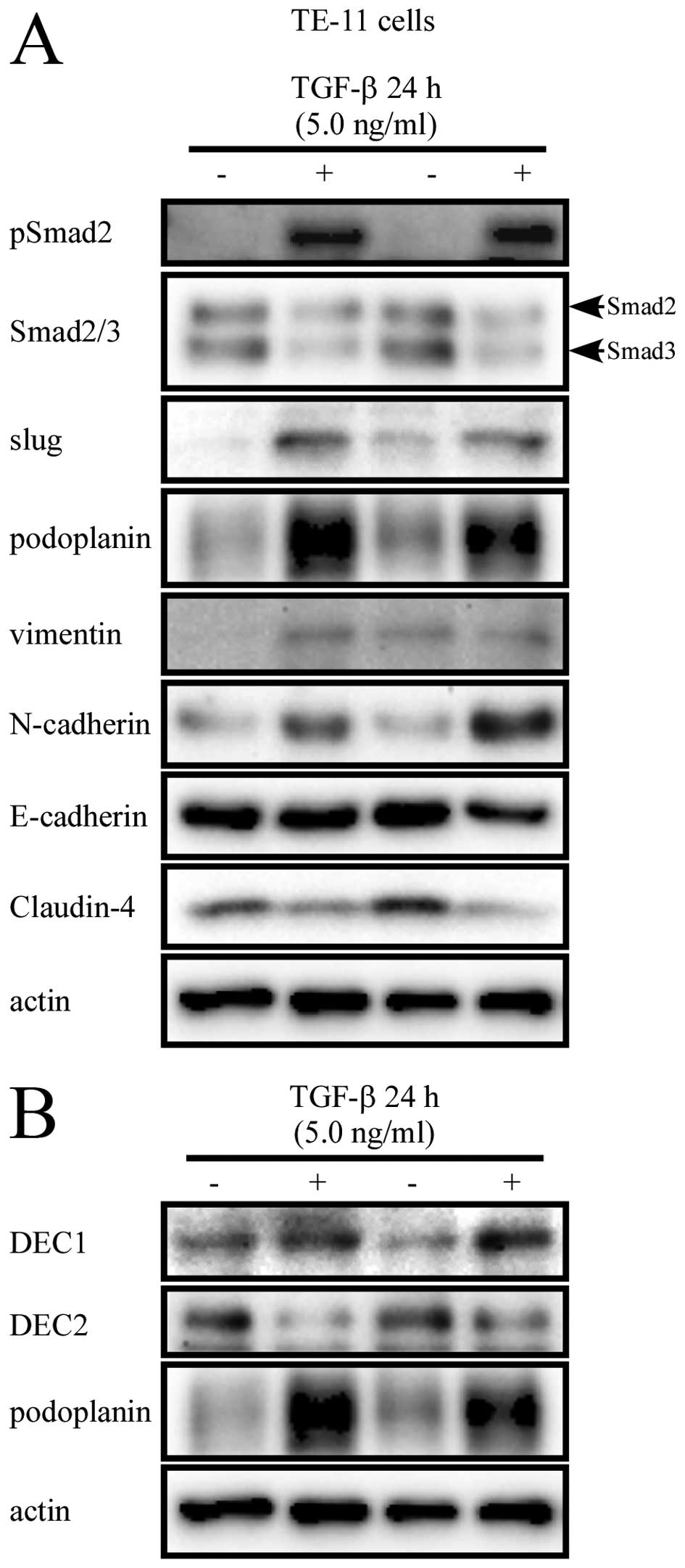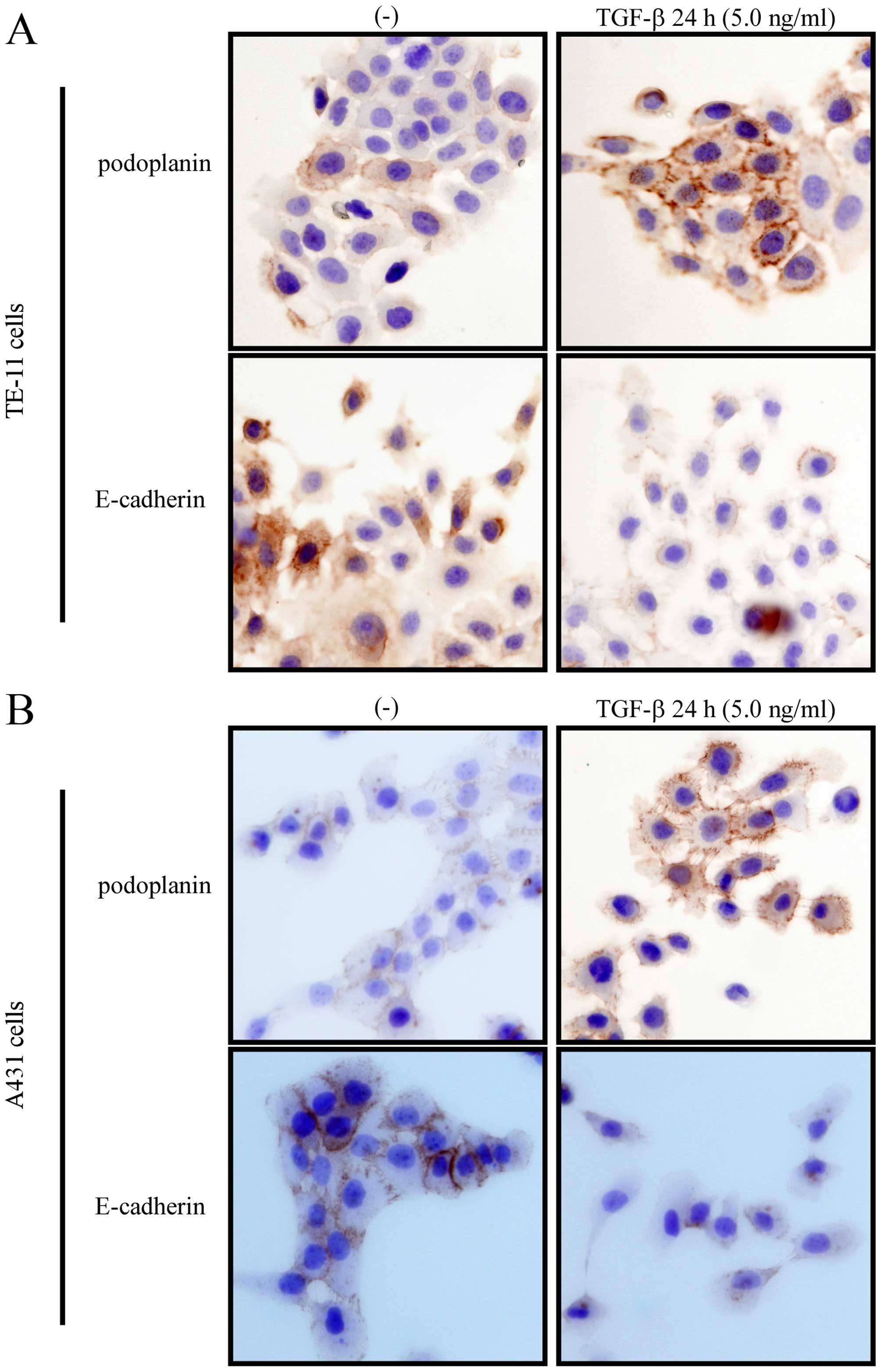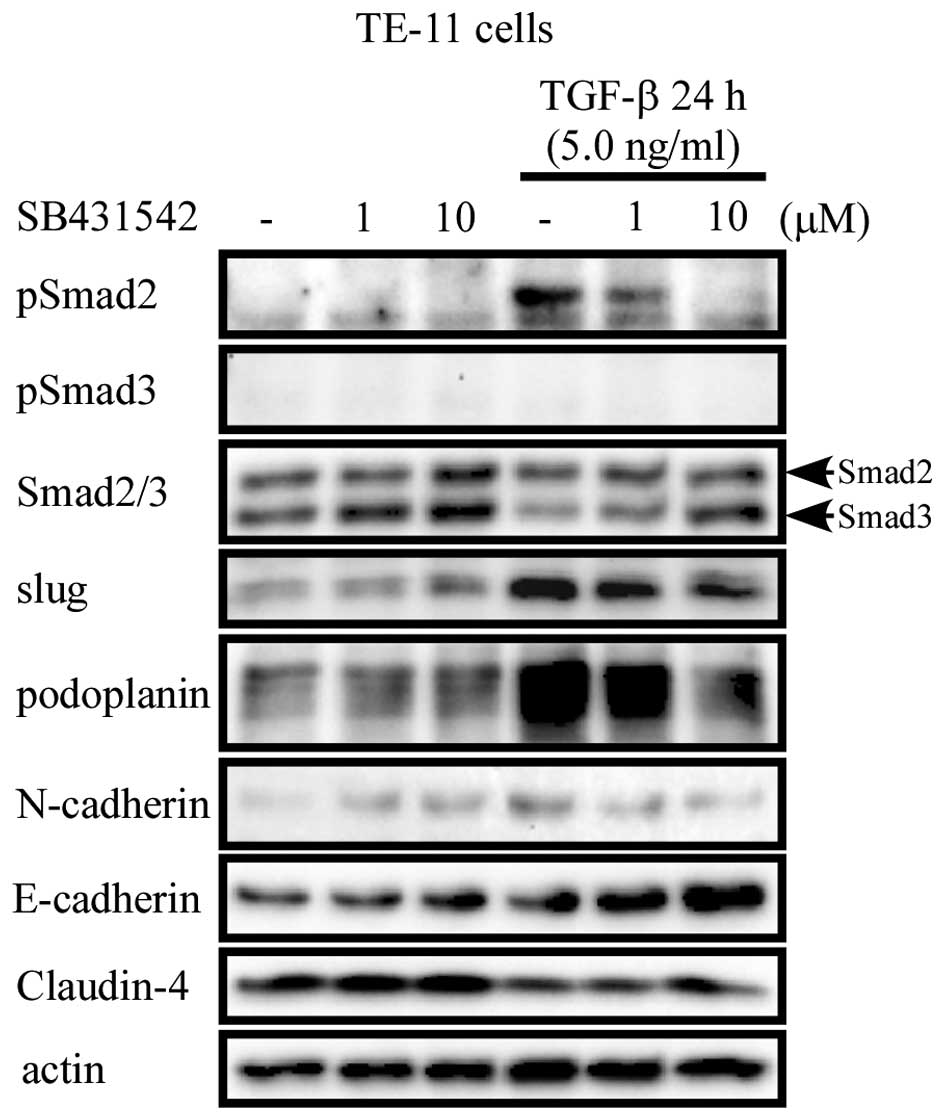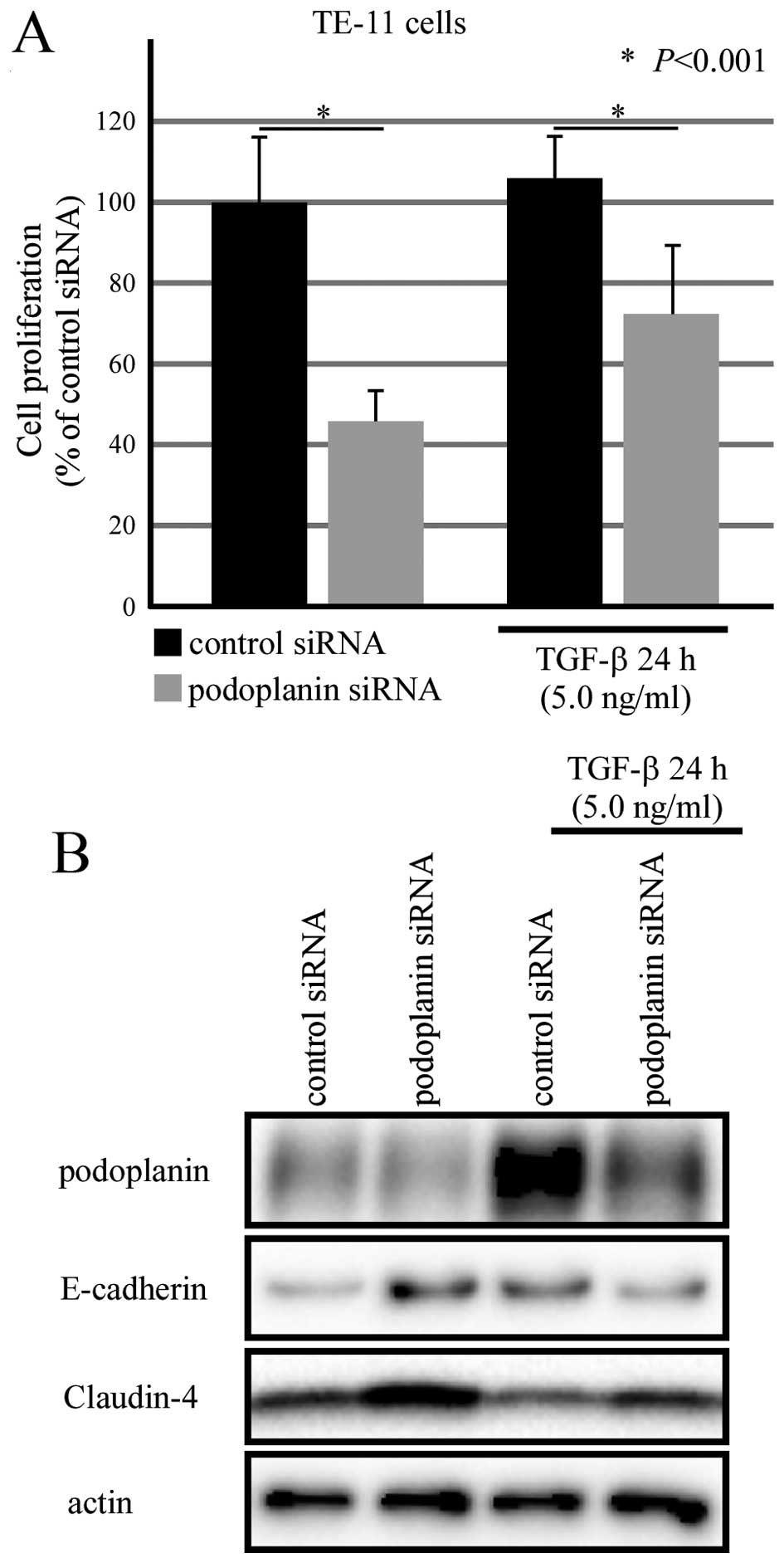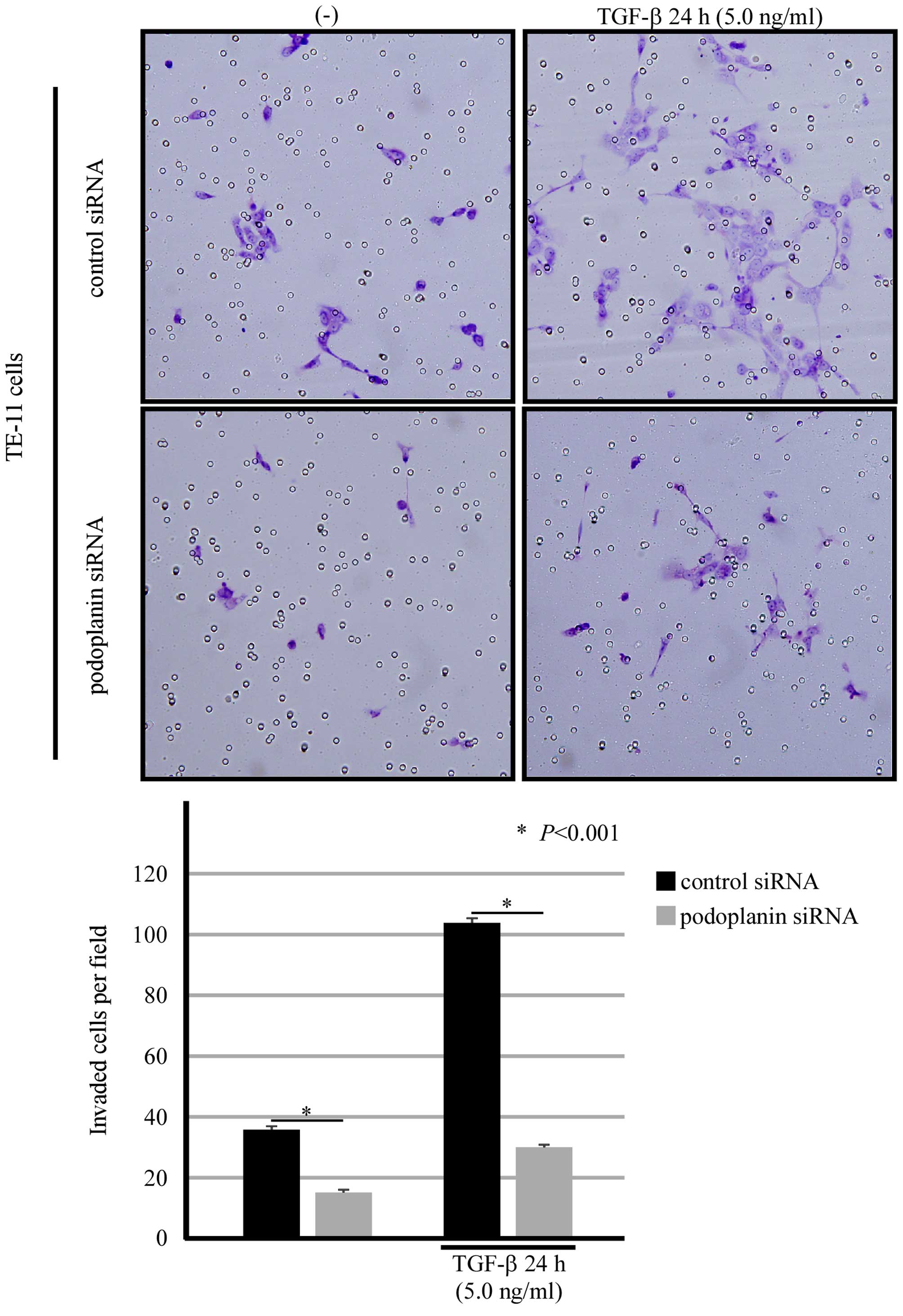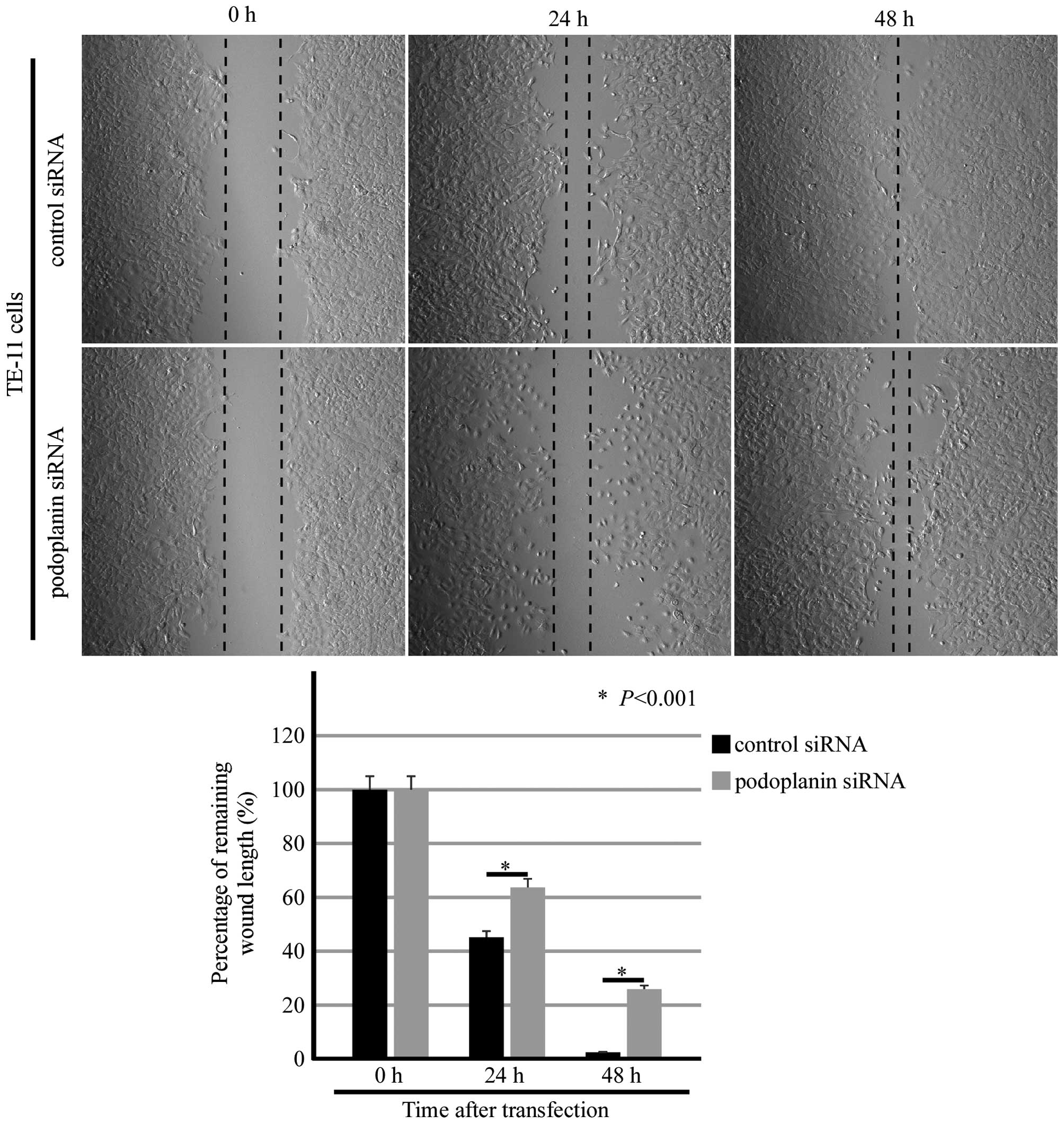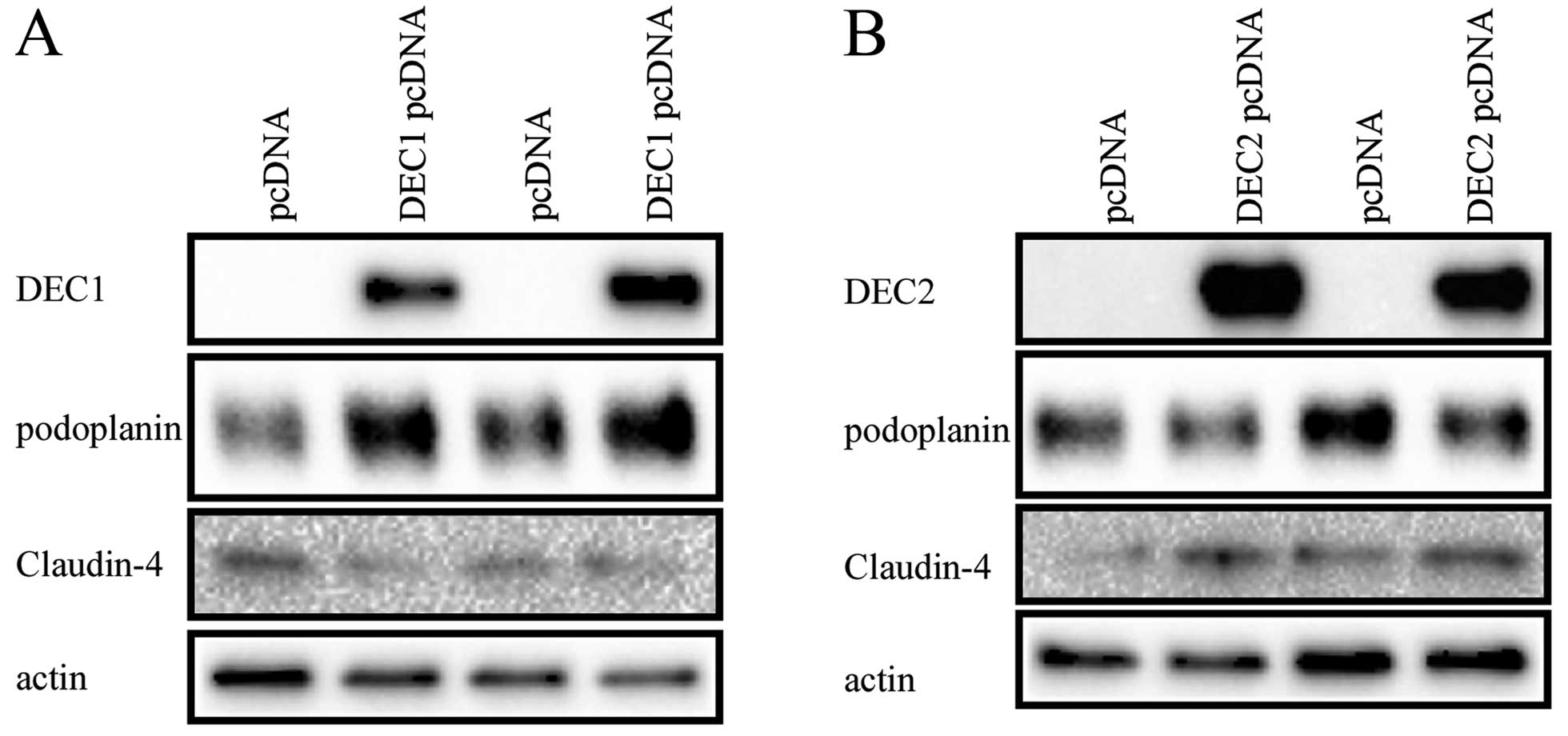Podoplanin-mediated TGF-β-induced epithelial-mesenchymal transition and its correlation with bHLH transcription factor DEC in TE-11 cells
- Authors:
- Published online on: March 18, 2016 https://doi.org/10.3892/ijo.2016.3445
- Pages: 2310-2320
-
Copyright: © Wu et al. This is an open access article distributed under the terms of Creative Commons Attribution License.
Abstract
Introduction
Podoplanin belongs to the family of type-I transmembrane sialomucin-like glycoproteins and possesses platelet-aggregating activity and metastasis-promoting ability (1,2). Due to its selective expression by lymphatic endothelial cells, it is widely used as a specific marker for lymphangiogenesis in many species (3). Podoplanin is also expressed by normal kidney podocytes (4), alveolar type I cells (5), basal epidermal keratinocytes (6), and mesothelial cells (7,8). Moreover, various tumor types highly express podoplanin, such as squamous cell carcinomas, brain tumors, mesotheliomas, germ cell tumors and some subtypes of vascular tumors (9–15).
Cancer cells undergo migration and invasion mainly dependent on the single cell-migration or the collective cell-migration (16). Generally, the invasion of single cell or small groups of cells is often correlated with dramatic changes in the expression and function of adhesive (e.g., cadherins, immunoglobulin domain-containing cell adhesion molecules) and regulatory proteins (e.g., Snail family members, transforming growth factor-β) (17). These changes are reminiscent of early developmental processes, in particular during neurulation and gastrulation, when cells acquire a migratory, mesenchymal phenotype. During this so-called epithelial-mesenchymal transition (EMT) cells lose epithelial markers, such as E-cadherin and Claudins, and gain the expression of mesenchymal markers, such as N-cadherin and vimentin. EMT is thought to be particularly important in cancers with single cell migration and early dissemination of tumor cells (17,18). In contrast, the migration of cell strands, cell sheets or clusters, named as collective cell-migration, is also present when epithelial tumors invade to neighboring tissue or migrate to distant organs (16).
Human differentiated embryonic chondrocyte (DEC) 1 (BHLHE40/Stra13/Sharp2) and DEC2 (BHLHE41/Stra13/Sharp1) are basic helix-loop-helix (bHLH) transcriptional factors that are involved in the regulation of cell differentiation, apoptosis, circadian rhythms, hypoxia responses, EMT and carcinogenesis. Our previous report showed that TGF-β upregulated the expression of DEC1 in the pancreatic adenocarcinoma cell line PANC-1 and described its close correlation with EMT phenomena (19).
Esophageal carcinoma is one of the most frequent cancers in the world. Squamous cell carcinoma and adenocarcinoma are the two common types among all the cases. Adenocarcinoma usually occurs in the lower esophagus or gastroesophageal junction, which is called Barrett's adenocarcinoma. In contrast, most squamous cell carcinomas locate in the middle or upper one-third of the esophagus (20). High expression level of podoplanin was reported to correlate with the poor prognosis of ESCC patients (21). However, the effects of podoplanin expression on EMT in ESCC have not been clarified. In this study, we focused on the role of podoplanin in TGF-β-induced EMT and its relation with DEC1 and DEC2 in TE-11 cells.
Materials and methods
Cell culture and treatment
Human esophagus carcinoma cell TE series (TE-10, TE-11 and TE-5) and human squamous cell carcinoma cell line A431 were purchased from the Riken BRC through the National Bio-Resource Project of the MEXT, Japan. The three cell lines of TE series were from well differentiated to poorly differentiated. The cells were cultured in RPMI-1640 medium supplemented with 10% fetal bovine serum at 37°C in a humidified atmosphere of 95% air and 5% CO2. A431 cells were cultured in DMEM medium supplemented with 10% fetal bovine serum. In some experiments, the cells were incubated with recombinant human TGF-β (R&D Systems, Minneapolis, MN, USA) or SB431542 (R&D Systems, Tocris Bioscience, UK) at various concentrations for 90 min.
Knockdown of podoplanin by RNA interference
Short interference RNA (siRNA) against podoplanin was purchased from Santa Cruz Biotechnology Inc. (TX, USA). For the siRNA transfection experiments, the cells were seeded at 5×104 cells per 35-mm well. Scrambled siRNA and siRNA against podoplanin were transfected into the cells 24 h later using the Lipofectamine RNA iMAX reagent (Invitrogen, Carlsbad, CA, USA). Following transfection, the cells were incubated for another 24 h and subjected to various analyses.
DEC1 and DEC2 overexpression
Human DEC1 and DEC2 plasmids were a kind gift of Dr Katsumi Fujimoto (Hiroshima University) (22). TE-11 cells were seeded at 5×104 cells per 35-mm well. DEC1 or DEC2 plasmid was transiently transfected into the cells 24 h later using the Lipofectamine LTX reagent (Invitrogen). Following transfection, the cells were incubated for another 18 h and subjected to western blot analyses.
Reverse transcription-quantitative polymerase chain reaction (RT-qPCR)
Four independent RNA samples (n=4) from TE-11 and A431 cells were prepared for RT-qPCR. Total RNA was isolated using an RNeasy RNA isolation kit (Qiagen, Hilden, Germany). First-strand cDNA was synthesized from 1 μg of total RNA using ReverTra Ace (Toyobo, Osaka, Japan). Quantitative PCR was carried out using Taq PCR Master Mix (Qiagen). The sequences, product sizes as well as cycling conditions of the primer sets are shown in Table I.
Western blotting
Cells treated with TGF-β (final concentration: 5.0 ng/ml) or transfected with siRNA were harvested and protein were extracted using M-PER lysis buffer (Thermo Scientific, Rockford, IL, USA). The protein concentrations were determined using the bicinchoninic acid (BCA method) assay. The obtained lysates (5 μg protein) were subjected to SDS-PAGE, and the separated proteins were transferred to PVDF membranes (Immobilon P, Millipore, Billerica, MA, USA), followed by immunoblotting utilizing the indicated antibodies. Signals were detected using Bio-Rad western blotting systems (Bio-Rad, Hercules, CA, USA) with the ECL-prime or ECL-select western blotting detection systems (GE Healthcare, Wauwatosa, WI, USA).
Immunocytochemical staining
TE-11 and A431 cells were seeded in a 4-well chamber slide glass and cultured with TGF-β at 5.0 ng/ml for 24 h. Cells were fixed with 4% paraformaldehyde in PBS for 30 min, followed by permeabilization with 0.2% Triton X-100 in PBS for 20 min. Normal horse serum (5%) was continued for 30 min to minimize the non-specific adsorption of antibodies. Subsequently, cells were incubated with antibody against podoplanin or E-cadherin at 4°C overnight. The cells were then incubated for 1 h with horseradish peroxidase-conjugated secondary antibody (Immuno-Biological Laboratories, Fujioka, Japan). Immunoreactivity was detected with a ready-to-us DAB+ substrate-chromogen solution (1–3 min) (Dako EnVision System; Dako Cytomation, Kyoto, Japan). Finally, the slides were counterstained with Mayer's hematoxylin for nuclear staining.
Cell proliferation assay
TE-11 cells seeded in the 96-well plate were transfected with siRNA against podoplanin, followed by TGF-β for an additional 24 h. Cells transfected with scrambled siRNA were used as control. Cell proliferation rate was determined using Cell Counting Kit-8 assay (CCK-8, Dojindo Molecular Technologies, Kumamoto, Japan) according to the manufacturer's instructions.
Invasion assay and wound-healing assay
The invasion assay was performed using a BD BioCoat Matrigel invasion chamber kit (Becton-Dickinson, Franklin Lakes, NJ, USA). TE-11 cells were separated using cell dissociation solution (Sigma) and 5×104 cells/600 μl were added to the top chamber of a cell culture insert in a 24-well companion plate. After 48-h incubation, the cells that had invaded the lower surface of the membrane were fixed with methanol and subjected to Giemsa staining. The number of the migrated cells was quantified by counting them in ten random distinct fields using a light microscope.
For wound-healing assay, TE-11 cells were seeded in a 4-well chamber slide glass, and an artificial ‘wound’ was carefully created by scratching the confluent cell monolayer with the tip of a P-200 pipette. Medium with the scratched out cells were changed and then the scrambled siRNA and podoplanin siRNA were transfected into the cells. Microphotographs were taken after 0, 24 and 48 h.
Results
Endogenous expression of podoplanin and EMT-related markers in ESCC cells
We investigated the level of podoplanin, EGFR, vimentin, N-cadherin, E-cadherin, Claudin-4 (Fig. 1A) as well as DEC1 and DEC2 (Fig. 1B) in four cell lines A431, TE-10, TE-11 and TE-5. Podoplanin showed an extremely strong expression in TE-11 cells but weak expression in A431 and TE-5 cells. While little or no expression of this protein was observed in the well differentiated ESCC TE-10 cells. A431 cells are generally used as a positive control for EGFR, we found that TE-11 cells exhibited a relatively large amount of EGFR. When referred to the mesenchymal markers, all of the four cell lines showed negative or weak expression of vimentin and N-cadherin. In contrast, they exhibited weak or strong expression of epithelial markers such as E-cadherin and Claudin-4. Interestingly, the level of E-cadherin and Claudin-4 was comparatively lower in TE-11 cells which had strong expression of podoplanin. A weak endogenous expression of both DEC1 and DEC2 was observed in all of the four cell lines.
Gene and protein expression changes when treated with TGF-β
To analyze the roles of podoplanin in epithelial-mesenchymal transition (EMT), TE-11 cell line with positive expression of podoplanin was selected in our study, and A431 cell line was used as control. Firstly, the two cell lines were cultured in the medium containing TGF-β, one of the well-known EMT inducers, at a final concentration of 5.0 ng/ml for 24 h. RT-qPCR and western blot analysis were used to investigate gene variation by TGF-β treatment. Both TGF-βRII and TGF-βRI were induced as expectably by its ligand. Transcriptional factor slug was involved in this process, however, snail was not activated by TGF-β in the two cell lines (data not shown). Podoplanin was sharply induced by TGF-β. Although a small amount of vimentin and N-cadherin was detected in TE-11 and A431 cells, they were upregulated by TGF-β in both the transcriptional and the translational levels. In contrast with this, the epithelial markers Claudin-4 and E-cadherin were downregulated (Fig. 2A). On the other hand, TGF-β caused the phosphorylation of Smad2 (Fig. 3A), but not that of Smad3 (data not shown). Consistent with the mRNA expression, the protein levels of slug, podoplanin, and mesenchymal markers were increased. However, the epithelial marker Claudin-4 was decreased, but E-cadherin protein showed a small decrease when treated with TGF-β. Immunocytochemically, TGF-β augmented the membrane or cytoplasmic expression of podoplanin, as well as decreased the expression of E-cadherin in cell-cell junction (Fig. 4). We also investigated the expression of DEC, TGF-β exerted inverse effects on DEC1 and DEC2. Moreover, podoplanin showed a similar expression pattern with DEC1, but an opposite pattern with DEC2, with TGF-β treatment (Figs. 2B and 3B).
Upregulation of podoplanin by TGF-β is TGF-βRI/II-dependent
To investigate the mechanisms by which TGF-β affected the expression of podoplanin, TE-11 cells were pre-treated with a selective inhibitor of TGF-β receptor I/II, SB431542 (1 and 10 μM) for 90 min, followed by culture with or without TGF-β for 24 h. TGF-β-induced phosphorylation of Smad2 was gradually inhibited by SB431542 in a dose-dependent manner. The expression of slug, podoplanin and N-cadherin showed a similar pattern with that of pSmad2. However, Claudin-4 and E-cadherin were upregulated when TGF-β receptor was blocked (Fig. 5).
Podoplanin knockdown inhibited the cell proliferation of TE-11 cells
To further clarify the roles of podoplanin in EMT, small interference RNA was used to knock down the expression of podoplanin. TE-11 cells cultured in 96-well plate were transfected with podoplanin siRNA for 24 h, followed by TGF-β treatment for another 24 h. Cell Counting Kit-8 was applied for analyzing the cell proliferation rate. As Fig. 6A shows, podoplanin siRNA inhibited cell proliferation of TE-11 cells in the presence and absence of TGF-β. Moreover, decreased podoplanin correlated with an increased expression of Claudin-4 regardless of TGF-β. However, unstable alterations of E-cadherin was observed between the scrambled siRNA group and podoplanin siRNA group (Fig. 6B).
Podoplanin was closely involved in the invasion and migration in TE-11 cells
The capacity of invasion and migration is the most important indicator of cancer cells entering EMT. Then we carried out an invasion assay in TE-11 cells which transiently transfected with siRNA against podoplanin. TE-11 cells transfected with scrambled siRNA showed weaker invasive ability, with the aid of TGF-β, the power of invasion was significantly strengthened. However, podoplanin knockdown strikingly inhibited the invasive ability of TE-11 cells (Fig. 7). In order to evaluate the ability of migration, wound-healing assay was introduced in podoplanin siRNA-transfected cells. Remaining wound length was measured after 0, 24 and 48 h of podoplanin siRNA transfection, and a significant difference between the control siRNA-transfected group and the podoplanin siRNA-transfected group was attained (Fig. 8). Morphologically, a small amount of the TE-11 cells in the middle of the chamber was dead in the podoplanin-siRNA transfected group, especially at the 24-h time-point.
Overexpression of DEC1 and DEC2 has distinct effects on podoplanin
To determine whether DEC1 or DEC2 directly regulated podoplanin, the expression vector of DEC1 or DEC2 was transfected into TE-11 cells. Podoplanin was induced by DEC1 overexpression, but reduced by DEC2 overexpression. Furthermore, a weak but inhibitory effect on Claudin-4 was observed in DEC1-overexpressed TE-11 cells, whereas a slightly but inducible effect on Claudin-4 in DEC2-overexpressed TE-11 cells (Fig. 9).
Discussion
We focused on the function of podoplanin in EMT of ESCC cells. Three cell lines among the human ESCC cell series, TE-10, TE-11 and TE-5, from well to poorly differentiated, were randomly chosen in our study, while A431 cells were used as control. It was found that the expression of podoplanin is independent of tumor differentiation, in which TE-11, a moderately differentiated cell line, possessed the highest level of podoplanin among the four cell lines. A reverse expression pattern of podoplanin and the epithelial markers such as E-cadherin and Claudin-4 was observed. In addition, the absence or weakly positive of vimentin and N-cadherin, two of the well-known mesenchymal markers was recorded in all of the four cell lines.
Upregulated podoplanin expression in squamous cell carcinoma tissues has been confirmed in previous reports (6,9,12,15). Although its expression was discussed in cancer cells, increasing interest has been attracted to its function in the cancer-associated fibroblasts (CAFs) which are located in the stroma surrounding various cancerous cells. Kawase et al suggested that stromal expression of podoplanin predicted a poor prognosis in lung carcinoma (23), while others showed an association between podoplanin expression and a better prognosis in patients with uterine cervical carcinomas and colorectal carcinomas (24,25). Functions of podoplanin-positive CAFs may rely on the type of tumor cells and the tissue from which the CAFs originate.
A variety of signaling agents and cytokines such as basic fibroblast growth factor, tumor necrosis factor α, TGF-β, IL-6, IL-22, or IFN-γ can induce podoplanin expression and cell motility (15,26–29). TGF-β is reported as a physiological regulator of podoplanin as well as stimulating the platelet-aggregating ability of human fibrosarcoma HT1080 cells (30). To our limit knowledge, this is the first report on TGF-β and podoplanin, involving their correlations with transcriptional factors DEC1 and DEC2 in TE-11 cells. As an EMT inducer, TGF-β induce pathological signaling in differentiated epithelial cells and lead to fundamental changes in cellular phenotype. These changes occurred in epithelial cells were accompanied by molecular re-organization such as loss of E-cadherin and gain of N-cadherin. This so-called cadherin switch is generally recognized as a rate-limiting step in the transition from adenoma to carcinoma (31,32).
In this study, we found an inverse expression pattern of podoplanin and E-cadherin, and the opposite effects by TGF-β treatment were observed in TE-11 cells. However, we failed to find a direct influence of podoplanin on E-cadherin. Unlike E-cadherin, the expression of Claudin-4 was upregulated when suppressing podoplanin in TE-11 cells. It is not surprising since podoplanin increased cell migration of MCF-7 cells and HaCaT keratinocytes in the presence of E-cadherin expression (15,29). In addition, invasion of podoplanin-expressing cells appeared to rely on the activity of matrix metalloproteases (MMPs), as it was repressed by TIMP2, an inhibitor of MMP. These data support the viewpoint that podoplanin expression in human cancers promotes migration and invasion of cancer cells without turning on the cadherin switch, whereas, it has been reported that MDCK cells demonstrated the expression of podoplanin leads to increased single cell migration after loss of E-cadherin expression (33). Therefore, podoplanin may induce cell invasion in both collective and single cell migration. Detailed mechanisms should be further investigated on the governors which decide the function of podoplanin to single cell-migration or collective cell-migration.
Regarding the involvement of podoplanin in cell movement, migration, and invasion, Martin-Villar et al showed the podoplanin interaction with ezrin in its cytoplasmic tail and with CD44 in its extracellular domain, which promote EMT and directional cell migration (33). In contrast, Wicki et al reported that podoplanin-induced collective cell migration and invasion by filopodia formation via the downregulation of the activities of RhoA GTPase, even in the absence of EMT (15). This study exhibited a negative correlation between podoplanin and Claudin-4, a molecule widely expressed at the tight junctions, affecting many cellular functions such as migration and adhesion, and its downregulation are linked to more invasive cancers. Since the cytoplasmic tail of podoplanin is extremely short, we predicted the function might mediate through ERM protein. However, further evidence is required to clarify this.
The roles of DEC1 and DEC2 on podoplanin need further clarification. DEC1 was reported to participate in TGF-β-induced EMT of PANC-1 cells in our previous study (19). In this study, we found DEC1 overexpression upregulated podoplanin but decreased Claudin-4 in TE-11 cells. It cannot be excluded that podoplanin might be a downstream factor of DEC1 in TGF-β signaling pathway for EMT. It seems that downregulation of podoplanin by DEC2 highlights another possibility that DEC2 might play a role in lymphogenesis. DEC2 has been confirmed to negatively regulate angiogenesis by inhibiting the expression of VEGF (34). Additionally, as a marker of lymphatic vessels, the function of podoplanin in lymphogenesis cannot be ignored. It is possible that DEC2 may inhibit lymphogenesis through regulating podoplanin. In conclusion, podoplanin may be a key factor as shown by its roles in EMT and lymphangiogenesis, and DEC2 as a new inhibitor of podoplanin was found in our study. The detailed mechanisms by which DEC2 regulate podoplanin should be further investigated.
Acknowledgements
This study was supported by Grants-in-Aid for Science from the Ministry of Education, Culture, Sports, Science, and Technology of Japan; a Grant for Hirosaki University Institutional Research; and the Fund for the Promotion of International Scientific Research.
Abbreviations:
|
TGF-β |
transforming growth factor-β |
|
EMT |
epithelial-mesenchymal transition |
|
DEC1 |
differentiated embryonic chondrocyte 1 |
|
DEC2 |
differentiated embryonic chondrocyte 2 |
References
|
Kato Y, Fujita N, Kunita A, Sato S, Kaneko M, Osawa M and Tsuruo T: Molecular identification of Aggrus/T1alpha as a platelet aggregation-inducing factor expressed in colorectal tumors. J Biol Chem. 278:51599–51605. 2003. View Article : Google Scholar : PubMed/NCBI | |
|
Kaneko M, Kato Y, Kunita A, Fujita N, Tsuruo T and Osawa M: Functional sialylated O-glycan to platelet aggregation on Aggrus (T1alpha/Podoplanin) molecules expressed in Chinese hamster ovary cells. J Biol Chem. 279:38838–38843. 2004. View Article : Google Scholar : PubMed/NCBI | |
|
Breiteneder-Geleff S, Soleiman A, Kowalski H, Horvat R, Amann G, Kriehuber E, Diem K, Weninger W, Tschachler E, Alitalo K, et al: Angiosarcomas express mixed endothelial phenotypes of blood and lymphatic capillaries: Podoplanin as a specific marker for lymphatic endothelium. Am J Pathol. 154:385–394. 1999. View Article : Google Scholar : PubMed/NCBI | |
|
Matsui K, Breitender-Geleff S, Soleiman A, Kowalski H and Kerjaschki D: Podoplanin, a novel 43-kDa membrane protein, controls the shape of podocytes. Nephrol Dial Transplant. 14(Suppl 1): 9–11. 1999. View Article : Google Scholar : PubMed/NCBI | |
|
Rishi AK, Joyce-Brady M, Fisher J, Dobbs LG, Floros J, VanderSpek J, Brody JS and Williams MC: Cloning, characterization, and development expression of a rat lung alveolar type I cell gene in embryonic endodermal and neural derivatives. Dev Biol. 167:294–306. 1995. View Article : Google Scholar : PubMed/NCBI | |
|
Schacht V, Dadras SS, Johnson LA, Jackson DG, Hong YK and Detmar M: Up-regulation of the lymphatic marker podoplanin, a mucin-type transmembrane glycoprotein, in human squamous cell carcinomas and germ cell tumors. Am J Pathol. 166:913–921. 2005. View Article : Google Scholar : PubMed/NCBI | |
|
Ordóñez NG: The diagnostic utility of immunohistochemistry and electron microscopy in distinguishing between peritoneal mesotheliomas and serous carcinomas: A comparative study. Mod Pathol. 19:34–48. 2006. View Article : Google Scholar | |
|
Wicki A and Christofori G: The potential role of podoplanin in tumour invasion. Br J Cancer. 96:1–5. 2007. View Article : Google Scholar | |
|
Kato Y, Kaneko M, Sata M, Fujita N, Tsuruo T and Osawa M: Enhanced expression of Aggrus (T1alpha/podoplanin), a platelet-aggregation-inducing factor in lung squamous cell carcinoma. Tumour Biol. 26:195–200. 2005. View Article : Google Scholar : PubMed/NCBI | |
|
Kato Y, Sasagawa I, Kaneko M, Osawa M, Fujita N and Tsuruo T: Aggrus: A diagnostic marker that distinguishes seminoma from embryonal carcinoma in testicular germ cell tumors. Oncogene. 23:8552–8556. 2004. View Article : Google Scholar : PubMed/NCBI | |
|
Kimura N and Kimura I: Podoplanin as a marker for mesothelioma. Pathol Int. 55:83–86. 2005. View Article : Google Scholar : PubMed/NCBI | |
|
Martin-Villar E, Scholl FG, Gamallo C, Yurrita MM, Muñoz-Guerra M, Cruces J and Quintanilla M: Characterization of human PA2.26 antigen (T1alpha-2, podoplanin), a small membrane mucin induced in oral squamous cell carcinomas. Int J Cancer. 113:899–910. 2005. View Article : Google Scholar | |
|
Mishima K, Kato Y, Kaneko MK, Nishikawa R, Hirose T and Matsutani M: Increased expression of podoplanin in malignant astrocytic tumors as a novel molecular marker of malignant progression. Acta Neuropathol. 111:483–488. 2006. View Article : Google Scholar : PubMed/NCBI | |
|
Naqvi J, Ordonez NG, Luna MA, Williams MD, Weber RS and El-Naggar AK: Epithelioid hemangioendothelioma of the head and neck: Role of podoplanin in the differential diagnosis. Head Neck Pathol. 2:25–30. 2008. View Article : Google Scholar : PubMed/NCBI | |
|
Wicki A, Lehembre F, Wick N, Hantusch B, Kerjaschki D and Christofori G: Tumor invasion in the absence of epithelial-mesenchymal transition: Podoplanin-mediated remodeling of the actin cytoskeleton. Cancer Cell. 9:261–272. 2006. View Article : Google Scholar : PubMed/NCBI | |
|
Friedl P and Wolf K: Tumour-cell invasion and migration: Diversity and escape mechanisms. Nat Rev Cancer. 3:362–374. 2003. View Article : Google Scholar : PubMed/NCBI | |
|
Thiery JP: Epithelial-mesenchymal transitions in tumour progression. Nat Rev Cancer. 2:442–454. 2002. View Article : Google Scholar : PubMed/NCBI | |
|
Lee JM, Dedhar S, Kalluri R and Thompson EW: The epithelial-mesenchymal transition: New insights in signaling, development, and disease. J Cell Biol. 172:973–981. 2006. View Article : Google Scholar : PubMed/NCBI | |
|
Wu Y, Sato F, Yamada T, et al: The BHLH transcription factor DEC1 plays an important role in the epithelial-mesenchymal transition of pancreatic cancer. Int J Oncol. 41:1337–1346. 2012.PubMed/NCBI | |
|
Torre LA, Bray F, Siegel RL, Ferlay J, Lortet-Tieulent J and Jemal A: Global cancer statistics, 2012. CA Cancer J Clin. 65:87–108. 2015. View Article : Google Scholar : PubMed/NCBI | |
|
Rahadiani N, Ikeda J, Makino T, Tian T, Qiu Y, Mamat S, Wang Y, Doki Y, Aozasa K and Morii E: Tumorigenic role of podoplanin in esophageal squamous-cell carcinoma. Ann Surg Oncol. 17:1311–1323. 2010. View Article : Google Scholar : PubMed/NCBI | |
|
Honma S, Kawamoto T, Takagi Y, Fujimoto K, Sato F, Noshiro M, Kato Y and Honma K: Dec1 and Dec2 are regulators of the mammalian molecular clock. Nature. 419:841–844. 2002. View Article : Google Scholar : PubMed/NCBI | |
|
Kawase A, Ishii G, Nagai K, Ito T, Nagano T, Murata Y, Hishida T, Nishimura M, Yoshida J, Suzuki K, et al: Podoplanin expression by cancer associated fibroblasts predicts poor prognosis of lung adenocarcinoma. Int J Cancer. 123:1053–1059. 2008. View Article : Google Scholar : PubMed/NCBI | |
|
Yamanashi T, Nakanishi Y, Fujii G, Akishima-Fukasawa Y, Moriya Y, Kanai Y, Watanabe M and Hirohashi S: Podoplanin expression identified in stromal fibroblasts as a favorable prognostic marker in patients with colorectal carcinoma. Oncology. 77:53–62. 2009. View Article : Google Scholar : PubMed/NCBI | |
|
Carvalho FM, Zaganelli FL, Almeida BG, Goes JC, Baracat EC and Carvalho JP: Prognostic value of podoplanin expression in intratumoral stroma and neoplastic cells of uterine cervical carcinomas. Clinics (Sao Paulo). 65:1279–1283. 2010. View Article : Google Scholar | |
|
Gandarillas A, Scholl FG, Benito N, Gamallo C and Quintanilla M: Induction of PA2.26, a cell-surface antigen expressed by active fibroblasts, in mouse epidermal keratinocytes during carcinogenesis. Mol Carcinog. 20:10–18. 1997. View Article : Google Scholar : PubMed/NCBI | |
|
Honma M, Minami-Hori M, Takahashi H and Iizuka H: Podoplanin expression in wound and hyperproliferative psoriatic epidermis: Regulation by TGF-beta and STAT-3 activating cytokines, IFN-gamma, IL-6, and IL-22. J Dermatol Sci. 65:134–140. 2012. View Article : Google Scholar | |
|
Nose K, Saito H and Kuroki T: Isolation of a gene sequence induced later by tumor-promoting 12-O-tetradecanoylphorbol-13-acetate in mouse osteoblastic cells (MC3T3-E1) and expressed constitutively in ras-transformed cells. Cell Growth Differ. 1:511–518. 1990.PubMed/NCBI | |
|
Scholl FG, Gamallo C, Vilaro S and Quintanilla M: Identification of PA2.26 antigen as a novel cell-surface mucin-type glycoprotein that induces plasma membrane extensions and increased motility in keratinocytes. J Cell Sci. 112:4601–4613. 1999.PubMed/NCBI | |
|
Suzuki H, Kato Y, Kaneko MK, Okita Y, Narimatsu H and Kato M: Induction of podoplanin by transforming growth factor-beta in human fibrosarcoma. FEBS Lett. 582:341–345. 2008. View Article : Google Scholar | |
|
Perl AK, Wilgenbus P, Dahl U, Semb H and Christofori G: A causal role for E-cadherin in the transition from adenoma to carcinoma. Nature. 392:190–193. 1998. View Article : Google Scholar : PubMed/NCBI | |
|
Li G and Herlyn M: Dynamics of intercellular communication during melanoma development. Mol Med Today. 6:163–169. 2000. View Article : Google Scholar : PubMed/NCBI | |
|
Martin-Villar E, Megias D, Castel S, Yurrita MM, Vilaro S and Quintanilla M: Podoplanin binds ERM proteins to activate RhoA and promote epithelial-mesenchymal transition. J Cell Sci. 119:4541–4553. 2006. View Article : Google Scholar : PubMed/NCBI | |
|
Sato F, Bhawal UK, Kawamoto T, Fujimoto K, Imaizumi T, Imanaka T, Kondo J, Koyanagi S, Noshiro M, Yoshida H, et al: Basic-helix-loop-helix (bHLH) transcription factor DEC2 negatively regulates vascular endothelial growth factor expression. Genes Cells. 13:131–144. 2008. View Article : Google Scholar : PubMed/NCBI |



